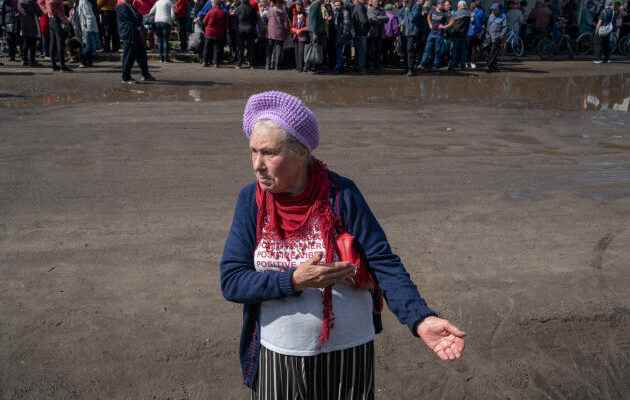Slowly, a woman in a dressing gown walks up the street, her arms dangling, as if she didn’t know where to go. Another pushes a rusty cart with a few logs piled up. Around a van, people silently wait for the distribution of a Bible and a bag of humanitarian aid, families and children staring blankly after six months of Russian occupation in Izium, eastern Ukraine. Tears flow down some faces, without a sob, no one pays attention. But here, the dead have been talked about more than the living since the city was liberated in mid-September.
During a demining operation, 445 individual graves were discovered by chance in a pine forest, outside the “Shakespeare” cemetery – that’s its name – near the western entrance to Izioum. Since then, Ukrainian President Volodymyr Zelensky, dozens of experts, forensic experts, magistrates, war crimes specialists, soldiers, journalists have walked the path through the tall pines to these graves, simple earth mounds, planted with a raw wooden cross, sometimes marked with a name, more often with a number.
The images went around the world, transforming Izioum into a city of the dead. Light must be shed, immediately demanded the Ukrainian head of state. All bodies will be autopsied and investigated. But what happened here? Who are these dead? Why are they there?
In the city center, a discreet plaque accompanied by a telephone number indicates, at the bottom of a building: “Ritual service and funerary monuments, 24 hours a day.” Vitaliy, 55, has been an undertaker in Izioum since 2004, along with nine other employees: it was he, he says, who took care of the burials at the Shakespeare cemetery. His company alone is said to have organized five times more funerals in the past six months than in peacetime. According to him, all would be civilians, with rare exceptions.
Vitaliy remembers the start of the Russian invasion in February, the bombardments, “the streets full of corpses”the 114 bodies found after the shelling of two buildings near the river in mid-March. “The occupiers first forbade us any burial, saying that they would take care of it”, says Vitaliy. But the bridge that separates the city has also been destroyed: the bodies must therefore be transported one by one, on foot, on a boardwalk. The Russian army gives up, and the company of Vitaliy receives an authorization.
Shakespeare Cemetery is designated as the primary burial site. The occupants have, in fact, already installed one of their bases in the surrounding pine forest, which will allow them to control the graves. But strategic Russian installations have been erected a little further in the woods, just behind the necropolis. No question of the undertakers approaching it: the burials must therefore take place in front of the cemetery, outside the walls.
You have 61.83% of this article left to read. The following is for subscribers only.
